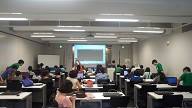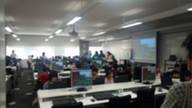本田 澄,伊原 彰紀,鷲崎 弘宜,深澤 良彰, “ソースコードの変更回数と不具合修正の関係分析に向けて”, 第32回日本ソフトウェア科学会大会, ポスター, 2015年9月10日.
「クラウドサービスの開発と運用においてセキュリティとプライバシを扱うためのメタモデル」コンピュータセキュリティシンポジウム2015 (CSS2015)にて発表予定
鷲崎 弘宜、福本 創太、山本 美聡、芳澤 正敏、大久保 隆夫、小形 真平、海谷 治彦、加藤 岳久、櫨山 淳雄、吉岡 信和、“クラウドサービスの開発と運用においてセキュリティとプライバシを扱うためのメタモデル”、コンピュータセキュリティシンポジウム2015 (CSS2015)、長崎ブリックホール、2015年10月21日(水) ~ 10月23日(金)
我々は、クラウドサービスにおけるセキュリティやプライバシを扱うメタモデルを定義する。同メタモデルを参照することで、一貫した形で効率的に事例やパターン、プラクティスといった事実や実証済みの知識を記述整理できる。記述整理した結果を知識ベースとして参照することにより、クラウドサービスの要求定義、設計、実装、運用、保守のあらゆるフェーズにおいて事実や実証済みの知識に基づいたセキュリティとプライバシの組み入れ、確認、改善を支援できる。さらにそれらを、同一のメタモデルに基づき、実装の詳細に立ち入らない参照アーキテクチャ上で一貫かつ追跡可能な形で実現することを支援できる。
「形式検証を用いた攻撃分析フレームワークの提案」コンピュータセキュリティシンポジウム2015 (CSS2015)にて共著発表
大久保隆夫、海谷治彦、鷲崎弘宣、吉岡信和、”形式検証を用いた攻撃分析フレームワークの提案”、コンピュータセキュリティシンポジウム2015 (CSS2015)、長崎ブリックホール、2015年10月21日(水) ~ 10月23日(金)
Research of Mutual Evaluation Method of Team Exercises to Enhance the Convincing, presentation scheduled on Sep 6 at JSAHP 2015.
Shoso Yamato, Hironori Washizaki, “Research of Mutual Evaluation Method of Team Exercises to Enhance the Convincing,” 4th Japanese International Symposium on the Analytic Hierarchy Process (JSASHP 2015), Nihon University, Tokyo, September 6, 2015. (to appear)
Focused Group Proposal titled “Improving Writer’s Workshop by Introducing Checklists and Perspectives” accepted at PLoP 2015
Tian Xia, Joseph Yoder, Rebecca Wirfs-Brock, Hironori Washizaki, “Improving Writer’s Workshop by Introducing Checklists and Perspectives,” Focused Group on 25 Oct, 22nd Conference on Pattern Languages of Programs Conference 2015 (PLoP 2015), October 24-26, Pittsburgh, Pennsylvania, USA.
「PBL活動を行う学生チームへの実装と支援の留意点」ソフトウェア科学会第32回大会にて共著発表
山戸昭三(愛媛大学), 鷲崎弘宜, “PBL活動を行う学生チームへの実装と支援の留意点”, 日本ソフトウェア科学会第32回大会, 早稲田大学, 2015年9月8-11日.
現実社会で活動している企業の課題に対して,IT システムを提供し活用することによって,解決しようとするPBL手法は,学生にとって多くの学びが期待される.教員は,学生チームの自律的な活動だけに任せるのではなく,より多くの教育効果が得られるように,顧客役の選定段階からIT ソリューションの顧客役への引継ぎまで,適時,適切な教育と支援が求められる.本論文では,筆者の経験と知識をもとに,学生チームへの教育と支援の留意点を論述する.
Minecraft x Education 2015 開催報告と御礼 早稲田大学グローバルソフトウェアエンジニアリング研究所 鷲崎弘宜
Minecraft(マインクラフト)を主要な題材として、コンピュータゲームを使った教育を考えるイベント「Minecraft × Education 2015 ~こどもとおとなのためのMinecraft」を、プログラミングスクールTENTO、早稲田大学グローバルソフトウェアエンジニアリング研究所、フジテレビKIDSの共同主催により、早稲田大学西早稲田キャンパス63号館を会場に8月8日・9日に開催いたしました。関係各位の多大なるご支援により、無事終了できたことを、深く感謝申し上げると共にご報告申し上げます。2日間でのべ1,500名の参加を得ることができました。またマスメディアにおける注目も高く、毎日新聞やファミ通、フジテレビなど多くの新聞やWeb・テレビ等の媒体に開催の様子をご紹介いただきました。
- ファミ通 http://www.famitsu.com/news/201508/11085649.html
- 4Gamer http://www.4gamer.net/games/126/G012627/20150810044/
- 毎日新聞 http://mainichi.jp/bizbuz/news/20150810dog00m020000000c.html
- AppBank http://www.appbank.net/2015/08/09/iphone-news/1075965.php
- ZDNet Japan http://japan.zdnet.com/article/35068737/
- PS.Blog https://www.jp.playstation.com/blog/detail/1314/20150811_minecraft.html
- フジテレビ ノンストップ http://www.fujitv.co.jp/nonstop/index.html
ご承知のように、Minecraftは箱庭のような自由な環境の中で単独あるいは共同でものづくりをするゲームであり、その教育や学習の効果が注目されています。その注目の高まりを受けて、本イベントは、Minecraftを主要な題材としてゲームを用いた教育と学習に関する研究者、実践者、教育者、学校関係者、学習者、保護者が一堂に会する国内最大規模の機会となり、Minecraftを用いた教育や学習の広がりを把握するとともに、ゲームを活用あるいは触発された教育と学習の未来の形を展望することができました。具体的には、本イベントでは講演中心のカンファレンス、講義中心のセミナー、体験型のワークショップ、ならびに、体験コーナー・併設実験プロジェクト等の各種イベント機会を設けました。
カンファレンスは、ゲームと教育に関する有識者らによる基調講演や短い招待講演(ライトニングトーク)ならびパネル討論(トークセッション)から構成したものとしました。カンファレンスでは、学習における自律性・自発性の重要性や、遊びやゲームを通した動機づけと創造性や協調性、さらにはITリテラシやプレゼンテーション・コミュニケーションスキルの獲得と育みについて議論を深め、従来の講義式教育から自発的体験的な学習への転換を通じた次世代に向けたゲームや遊びを通じた教育・学習の未来を展望しました。その中で、Minecraftが従来のゲームの枠を超えた教育学習プラットフォームとして優れていることを改めて認識し、そのさらなる今後の可能性を探る機会となりました。
セミナーでは主として教育者や保護者を対象に、Minecraftの教育への活用を支援することを目的として、プログラミング教育の実践報告や、各種環境の構築と活用に関する専門家からの講義があり、参加者は熱心に学んでいました。セミナーにおいてはさらに、Minecraftに親しむ現役高校生の声を直接に聞く機会も設け、特に保護者にとってその魅力や今後の扱いについて学び検討する貴重な機会となりました。
ワークショップでは、小中学生から一般まで幅広く様々な年齢層や立場向けに、Minecraftを用いた論理回路やプログラミング、コミュニケーション、さらには教科一般(特に語学)を学習する具体的な体験機会を設け、参加者が体験をもって深く学ぶ機会となりました。そのうちの一部は公開ワークショップ「赤石先生のRedstone特別講座」として広く見学可能とする共に講師およびカンファレンス登壇者が講評し、学習・教育の効果と可能性について議論および参加者に伝える機会となり、多くの聴衆を集めました。その模様は収録され、今後Web上でさらに広く配信される予定です。公開ワークショップを除くすべてのワークショップはWindows PC上に、教育用のMinecraftEduをインストールして実施し、MinecraftEduが教育用途に優れていることを実証する機会ともなりました。
その他の各種イベント機会としては、協賛団体の皆様のご協力によりPlayStation Vita、 PlayStation 4、Xbox One をはじめ、さまざまなプレイ環境においてMinecraftを体験する機会を設けるとともに、グッズや書籍その他の販売を通じてMinecraftや関連技術に幅広く触れていただく機会を設けました。さらに併設実験プロジェクトとして、従来の制限を超えて1000人以上で同時にMinecraftをプレイするプロジェクト「みんなでマインクラフト」を会期中に実施し、直接の来場者のみならずインターネット上で遠隔地から本イベントの一端に参加する機会を提供すると共に、多人数プレイにおけるサーバ環境や運用におけるノウハウの蓄積に成功しました。これらの成果は今後Web等で公開する予定です。
本イベントは大きな問題もなく順調に運営ができたと思っております。これは、後援団体、協賛団体、協力団体の皆様の多大なご支援、さらには、主催したTENTOのスクール受講生・保護者、フジテレビKIDS関係者、そして早稲田大学の関係者・教職員・在学生の情熱的な運営活動によるところであり、心より御礼申し上げます。
本イベントはMinecraftとEducationをキーワードとして、普段はともすれば接点のない人々が立場や世代を超えて繋がり、ゲームと教育・学習の今と未来を多面的かつ深く議論する国内最大規模の機会となりました。繋がりをより国内外さらには様々な世代へと広げ、展望した未来を具現化しつつさらなる先を切り拓くにあたり、関係各位のご協力を経てぜひ今後も発展的に継続開催したいと考えております。引き続きご支援ご協力を賜りますようお願い申し上げます。
末筆ではございますが、あらためて本イベントをご支援いただきました皆様に対して心より御礼を申し上げます。
2015年8月12日 早稲田大学グローバルソフトウェアエンジニアリング研究所 鷲崎弘宜
QA to AQ Part Four – Shifting from Quality Assurance to Agile Quality – Prioritizing Qualities and Making them Visible, accepted at PLoP 2015 (CORE Rank B)
Joseph W. Yoder, Rebecca WirfsBrock, Hironori Washizaki, “QA to AQ Part Four – Shifting from Quality Assurance to Agile Quality – Prioritizing Qualities and Making them Visible,” Proceedings of the 22nd Conference on Pattern Languages of Programs Conference 2015 (PLoP 2015), October 24-26, Pittsburgh, Pennsylvania, USA. (CORE Rank B) (to appear)
Two-level Checklists and Perspectives: Software Reading Techniques for Pattern Writer’s Workshop, accepted at PLoP 2015 (CORE Rank B)
TIAN XIA, HIRONORI WASHIZAKI, YOSHIAKI FUKAZAWA, JOSEPH YODER, REBECCA WIRFS-BROCK, “Two-level Checklists and Perspectives: Software Reading Techniques for Pattern Writer’s Workshop,” Proceedings of the 22nd Conference on Pattern Languages of Programs Conference 2015 (PLoP 2015), October 24-26, Pittsburgh, Pennsylvania, USA. (CORE Rank B) (to appear)
A Pattern Writer’s Workshop (WW) is a peer-review method to improve pattern or pattern language papers. However, several problems may arise, leading to “ad hoc” review meetings where patterns are not systematically reviewed and authors do not receive useful feedback. Previously, we considered Checklist-based Reading (CBR) and Perspective-based Reading (PBR), which are techniques to improve ad hoc reviews, but some deficiencies were noted. In this paper, we propose an approach to improve WWs by providing a two-level checklist and refining perspectives for reviewing patterns. An experiment shows the strengths and weaknesses of this new approach.
Systematic Mapping of Security Patterns Research, accepted at PLoP 2015 (CORE Rank B).
Yurina Ito, Hironori Washizaki, Masatoshi Yoshizawa, Yoshiaki Fukazawa,
Takao Okubo, Haruhiko Kaiya, Atsuo Hazeyama, Nobukazu Yoshioka, Eduardo B. Fernandez, “Systematic Mapping of Security Patterns Research,” Proceedings of the 22nd Conference on Pattern Languages of Programs Conference 2015 (PLoP 2015), October 24-26, Pittsburgh, Pennsylvania, USA. (CORE Rank B) (to appear)
Security patterns (SPs) are reusable solutions to security problems. We study here research papers that use security patterns to build secure systems or analyze the nature of security patterns. The goal of this paper is neither listing nor direct mapping of existing over 200 SPs but finding about how SPs are being investigated within research works to guide future research targeting SPs. Although the number of SPs has recently grown, two critical problems remain due to the diversity in the results themselves and how they are shared. First, it is unclear whether or not the field is actively growing. Second, the trends in SP research (e.g., research content and their modeling methods of SPs) are uncertain. To elucidate the current trends, herein we classify 30 works on SPs using a technique called systematic mapping (SM), which reveals the following characteristics. As the frequency of less common patterns (e.g., reference monitor) increases, the amount of practical research (e.g., experimental evaluations) also increases; Regardless of SPs to be dealt with, the most common SP modeling method is UML followed by other modeling methods for specific purposes, demonstrating the importance of modeling methods complementing each other; Currently one the most common research topics is applying SPs, suggesting that the demand for efficient and reliable techniques to applying SPs is high; Future studies should examine other SPs in addition to access control to handle various threats as well as to investigate the analysis/requirement and test phases; Accumulated knowledge on SPs should improve research requiring precise modeling.

